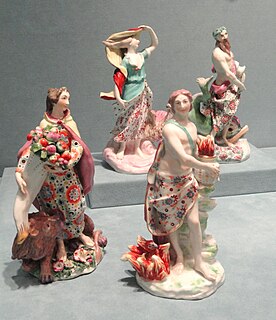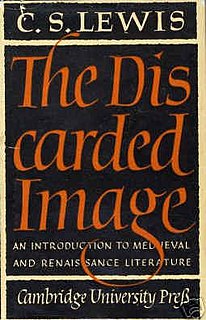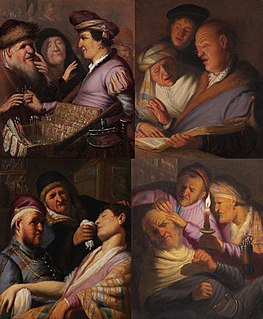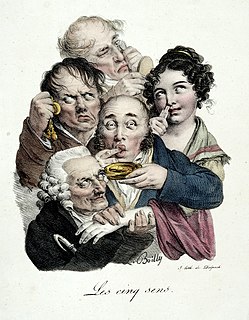Related Research Articles

Classical elements typically refer to water, earth, fire, air, and (later) aether, which were proposed to explain the nature and complexity of all matter in terms of simpler substances. Ancient cultures in Greece, Tibet, and India had similar lists, sometimes referring in local languages to "air" as "wind" and the fifth element as "void".
Imagery is visual symbolism, or figurative language that evokes a mental image or other kinds of sense impressions, especially in a literary work, but also in other activities such as psychotherapy.

The Lady and the Unicorn is the modern title given to a series of six tapestries created in the style of mille-fleurs and woven in Flanders from wool and silk, from designs ("cartoons") drawn in Paris around 1500. The set, on display in the Musée de Cluny in Paris, is often considered one of the greatest works of art of the Middle Ages in Europe.
Pratyahara or the 'withdrawal of the senses' is the fifth element among the Eight stages of Patanjali's Ashtanga Yoga, as mentioned in his classical work, Yoga Sutras of Patanjali composed in the 2nd century BCE. It is also the first stage of the six-branch yoga (ṣaḍaṅgayoga) of the Buddhist Kālacakra tantra, where it refers to the withdrawal of the five senses from external objects to be replaced by the mentally created senses of an enlightened deity. This phase is roughly analogous to the physical isolation phase of Guhyasamāja tantra.
Five senses refers to the five traditionally recognized methods of perception, or sense: taste, sight, touch, smell, and sound.

On the Soul is a major treatise written by Aristotle c. 350 BC. His discussion centres on the kinds of souls possessed by different kinds of living things, distinguished by their different operations. Thus plants have the capacity for nourishment and reproduction, the minimum that must be possessed by any kind of living organism. Lower animals have, in addition, the powers of sense-perception and self-motion (action). Humans have all these as well as intellect.
In medicine and anatomy, the special senses are the senses that have specialized organs devoted to them:

Sonnet 141 is the informal name given to the 141st of William Shakespeare's 154 sonnets. The theme of the sonnet is the discrepancy between the poet's physical senses and wits (intellect) on the one hand and his heart on the other. The "five wits" that are mentioned refer to the mental faculties of common sense, imagination, fantasy, instinct, and memory. The sonnet is one of several in which the poet's heart is infatuated despite what his eyes can see.

The Five Senses is a 1999 Canadian drama film directed, written and produced by Jeremy Podeswa.

The Discarded Image: An Introduction to Medieval and Renaissance Literature is a non-fiction book by C. S. Lewis. It was his last book and deals with medieval cosmology and the Ptolemaic universe. It portrays the medieval conception of a "model" of the world, which Lewis described as "the medieval synthesis itself, the whole organization of their theology, science and history into a single, complex, harmonious mental model of the universe."

Common sense is sound, practical judgment concerning everyday matters, or a basic ability to perceive, understand, and judge in a manner that is shared by nearly all people.
A sense is a biological system used by an organism for sensation, the process of gathering information about the world and responding to stimuli. Although traditionally around five human senses were known, it is now recognized that there are many more. Senses used by other non-human organisms are even greater in variety and number. During sensation, sense organs collect various stimuli for transduction, meaning transformation into a form that can be understood by the brain. Sensation and perception are fundamental to nearly every aspect of an organism's cognition, behavior and thought.
Many types of sense loss occur due to a dysfunctional sensation process, whether it be ineffective receptors, nerve damage, or cerebral impairment. Unlike agnosia, these impairments are due to damages prior to the perception process.

The wax argument or the ball of wax example is a thought experiment that René Descartes created in the second of his Meditations on First Philosophy. He devised it to analyze what properties are essential for bodies, show how uncertain our knowledge of the world is compared to our knowledge of our minds, and argue for rationalism.

The Five Senses is a set of allegorical paintings created at Antwerp in 1617–18 by Jan Brueghel the Elder and Peter Paul Rubens, with Brueghel being responsible for the settings and Rubens for the figures. They are now in the Prado Museum in Madrid. They are all painted in oils on wood panel, approximately 65 by 110 centimetres in dimensions.

The Five Senses are a pair of oil paintings made by Jan Brueghel the Elder and others in 1617–18, at the same time as he was working with Peter Paul Rubens on a series of five paintings on the same topic. The originals were lost in a fire in 1731; faithful copies dated to c. 1620 were preserved and are in the Prado Museum in Madrid.

The Senses is a series of five oil paintings, completed c. 1624 or 1625 by Rembrandt, depicting the five senses. The whereabouts of one, representing the sense of taste, is unknown. Another, representing smell, was only re-identified in 2015.
Sensory tourism is a form of tourism, that caters for people with vision impairment. Those suffering from vision impairment face many difficulties based around mainstream tourism such as access to information, navigation, safety and the knowledge of others around them. This has caused the visionless members of society to travel much less than those with no vision impairment. Combining the theories behind tourism in terms of its psychology and its relation to the senses, an inclusive experience for the visually disabled was developed. Sensory tourism engages the physical and multi-sensory aspects of tourism, enhancing the tourism experience specifically for those with, but also benefitting those without vision impairment.

Sensory history is an area of academic study which examines the role the five senses have played in the past. It developed partly as a reaction to the lack of serious attention given to sensory experience in traditional history books, which often treat sensory experience as a writing technique rather than a serious avenue of enquiry. Works of sensory history try to convey a deeper understanding of the past through an emphasis on physical experiences.
References
- ↑ Stephen Hawes. The Pastime Of Pleasure. Early English Poetry, Ballads and Popular Literature of the Middle Ages. XVII. Read Books.
- ↑ Richard Morris (ed.). Cursor Mundi . Read Books. p. 974.
- 1 2 3 4 5 6 Horace Howard Furness (1880). "King Lear". Shakespeare. 5 (7th ed.). Philadelphia: J.B. Lippincott Co. p. 187. ISBN 9780742652866.
- ↑ "wit". The Merriam-Webster new book of word histories . Merriam-Webster. 1991. pp. 508. ISBN 9780877796039.
- ↑ Clive Staples Lewis (1990). "Sense". Studies in Words (2nd (republished) ed.). Cambridge University Press. p. 147. ISBN 9780521398312.
- ↑ Charles Laurence Barber (1997). "Changes of Meaning". Early modern English. Edinburgh University Press. p. 245. ISBN 9780748608355.
- 1 2 John Raymond Postgate (1995). "Microsenses". The outer reaches of life. Cambridge University Press. p. 165. ISBN 9780521558730.
- ↑ Lewis, C. S. (1964). The Discarded Image: An introduction to Medieval and Renaissance literature . Cambridge, UK: Cambridge University Press. pp. 162, 164.
- ↑ Hankins, John Erskine (1978). Backgrounds of Shakespeare's thought. Archon Books. p. 73. ISBN 9780208017437.
- 1 2 Mares, Francis Hugh (2003). Much ado about nothing by William Shakespeare (2nd ed.). Cambridge, UK: Cambridge University Press. p. 67. ISBN 9780521532501.
- ↑ Kolve, V. A. (1984). Chaucer and the Imagery of Narrative. Paolo Alto, CA: Stanford University Press. pp. 20–22. ISBN 0-8047-1349-9.
- ↑ Augustine (1990). The works of Saint Augustine. New York: Augustinian Heritage Institute. p. 470. ISBN 978-1-56548-175-6.
- ↑ John Payne Collier and Henry R. Cook (1843). "King Lear". The works of William Shakespeare. VII. London: Whitaker & Co. p. 426.
- ↑ Sarah M. Horrall, ed. (1978). The Southern Version of Cursor Mundi: Lines 1-9228. University of Ottawa Press. p. 350. ISBN 9780776648057.
- 1 2 3 Horace Howard Furness (1899). "Romeo and Juliet". Shakespeare. 1 (10th ed.). Philadelphia: J.B. Lippincott Co. p. 60. ISBN 9780742652828.
- 1 2 3 4 5 6 Earl R. Anderson (2003). "The Five Senses". Folk-taxonomies in early English. Fairleigh Dickinson Univ Press. ISBN 9780838639160.